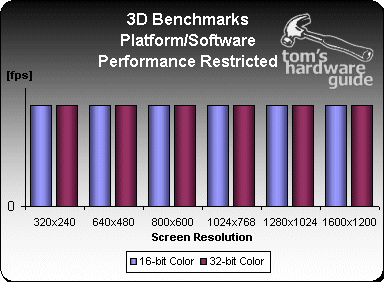3D Benchmarking - Understanding Frame Rate Scores
1. The Impact Of The Platform, Continued
This graph shows you how a 3D-benchmark looks if 'the platform' should be the limiting factor. The frame rate won't decrease at higher resolutions or higher color depth, because the 3D chip is permanently waiting for the 3D-data from 'the platform'. In this case a faster 3D-chip won't get you any higher frame rates.
Unreal Tournament has a rather ineffective engine when it comes to the usage of 'the platform'. Therefore a fast 3D chip will always wait for 'the platform':
You can see that there's hardly any change in frame rate over the resolutions, particularly not in case of the Celeron 600 system. However, what you can see is that a faster CPU translates directly into higher frame rates. For Unreal Tournament you rather want to go for a fast CPU than for the fastest graphics card.
The situation is similar if you use a processor that's not fast enough to evaluate different 3D-cards. If the 'platform' is the bottleneck, you will get identical frame rates with completely different 3D-cards. Many 'reviewers' have in this case claimed "the different cards perform almost the same! ", simply because they were using a slow platform. Make always sure that 3D-card evaluations are using a platform that is at least as fast as your own! Otherwise the results won't help you at all!
Get Tom's Hardware's best news and in-depth reviews, straight to your inbox.
Current page: 1. The Impact Of The Platform, Continued
Prev Page Introduction Next Page 2. The Impact Of The Fill Rate
